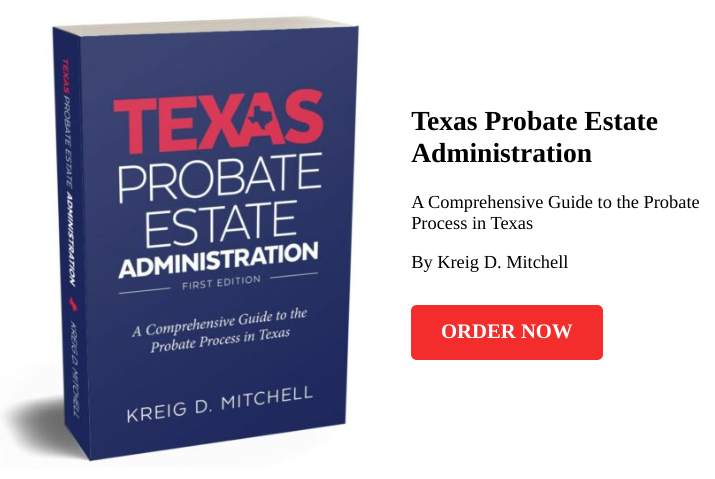Probate in Texas should be viewed as a process. It is a process that has several steps that have to be completed. The end goal of these steps is to resolve family and other disputes and identify, manage, and distribute the decedent’s property. With these goals in mind, here is a very general explanation of how probate works in Texas.
Probate Starts With the Will
The first step involves examining the will and estate plan to ensure that it is valid. This may include a review of the formalities of the document, i.e., was it signed by the decedent, witnessed by two subscribing witnesses, and, preferably, have a self-proving affidavit attached to it. Alternatively, is the document written entirely in the decedent’s handwriting and signed by the decedent? Does the document name an executor and/or say how property is to be disposed of at death?
Here are the other items that should be addressed in the will:
- The will should say whether the probate is independent or dependent. The independent administration is the standard but has to either be provided for in the will or by agreement of the heirs. Dependent administration is a formal process that is supervised by the court–which can be helpful if there are disputes but can be more costly.
- The will should name the person or persons to serve as the executor. Even if this person or persons are named, there are times when this person cannot or will not serve. There are other times when this person is not suitable to serve–such as when they are out of state.
- The will should provide a clear statement as to how assets are to be distributed among the beneficiaries. This language should be carefully examined as disputes here are common. For example, a reference to a “house” may not be clear as to which house. The will may include a residuary clause that disposes of property generally. Absent this, one may have to consider Texas intestacy laws for instruction on how to distribute assets.
The next steps involve the probate court.
The Probate Court
The probate is a court process. This means that one has to identify the court in which to start the process and file an application with the court.
There are several courts to choose from. This can include statutory probate courts, county courts, and district courts. There are also several different counties where the probate may be brought in–including the county where the decedent lived, where they had property, etc.
The application itself has to meet the statutory requirements. These requirements are set out in the Texas Estates Code. Then one has to ensure that citation is issued on the application. The Oath, Proof of Death, Judgment, and Proposed Order should also be filed, but practices vary from county to county.
The original will has to be lodged with the clerk, so that the court can review it. The hearing has to be scheduled and then the court hearing has to be completed. This includes providing testimony to prove up the will and the qualifications of the executor.
If successful, the court will issue letters testamentary. This is the document that evidences the executor’s power to administer the estate.
Probate Administration
After court, the probate administration process starts.
This starts with notice of the probate being run in the appropriate newspaper. This is followed by notice to secured and unsecured creditors. Then there is a gathering of assets and setting up the estate. This includes getting estate bank accounts and taxpayer numbers, and moving the assets to the estate so that they can be managed.
Tax returns have to be filed–both for the decedent’s last returns and the estate tax returns.
The executor has a hard deadline to file an inventory for the estate. The inventory lists any assets, claims against the estate, and provides values of each.
Once creditor claims are submitted and paid or rejected, the executor can consider making distributions to the beneficiaries in the will. This may include partial or full distributions.
If the estate goes more than one year, annual accountings should be filed.
Absent any probate disputes or issues, the estate can then be closed. There are several options for how to close the probate, including a formal closing or just notice.
The Takeaway
Navigating the probate process in Texas may initially seem overwhelming, but by breaking it down into manageable steps, you can approach it with confidence. Remember to seek legal advice from a qualified probate attorney to ensure compliance with the applicable laws and regulations. By following this step-by-step guide, you’ll be better equipped to handle the probate process and ensure a smooth resolution of your loved one’s estate.
Do you need help with a probate matter in Austin or the surrounding area? We are Austin probate attorneys. We help clients navigate the probate process. Call today for a free confidential consultation, 512-273-7444.
Our Austin Probate Attorneys provide a full range of probate services to our clients, including helping with probate administration. Affordable rates, fixed fees, and payment plans are available. We provide step-by-step instructions, guidance, checklists, and more for completing the probate process. We have years of combined experience we can use to support and guide you with probate and estate matters. Call us today for a FREE attorney consultation.
Disclaimer
The content of this website is for informational purposes only and should not be construed as legal advice. The information presented may not apply to your situation and should not be acted upon without consulting a qualified probate attorney. We encourage you to seek the advice of a competent attorney with any legal questions you may have.




